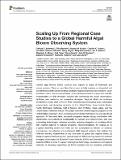Por favor, use este identificador para citar o enlazar a este item:
http://hdl.handle.net/10261/185707COMPARTIR / EXPORTAR:
 SHARE SHARE
 CORE
BASE CORE
BASE
|
|
| Visualizar otros formatos: MARC | Dublin Core | RDF | ORE | MODS | METS | DIDL | DATACITE | |

| Título: | Scaling Up From Regional Case Studies to a Global Harmful Algal Bloom Observing System |
Autor: | Anderson, Clarissa R.; Berdalet, Elisa CSIC ORCID ; Kudela, Raphael; Cusack, Caroline K.; Silke, Joe; O'Rourke, Eleanor; Dugan, Darcy; McCammon, Molly; Newton, Jan A.; Moore, Stephanie; Paige, Kelli; Ruberg, Stve; Morrison, John R.; Kirkpatrick, Barbara; Hubbard, Katherine; Morell, Julio | Palabras clave: | Biodiversity Biotoxins Phycotoxin Ecological Forecasting Early warning systems Stakeholder engagement Earth system science Phytoplankton |
Fecha de publicación: | may-2019 | Editor: | Frontiers Media | Citación: | Frontiers in Marine Science 6: 250 (2019) | Resumen: | Harmful algal blooms (HABs) produce local impacts in nearly all freshwater and marine systems. They are a problem that occurs globally requiring an integrated and coordinated scientific understanding, leading to regional responses and solutions. Given that these natural phenomena will never be completely eliminated, an improved scientific understanding of HAB dynamics coupled with monitoring and ocean observations, facilitates new prediction and prevention strategies. Regional efforts are underway worldwide to create state-of-the-art HAB monitoring and forecasting tools, vulnerability assessments, and observing networks. In the United States, these include Alaska, Pacific Northwest, California, Gulf of Mexico, Gulf of Maine, Great Lakes, and the United States Caribbean islands. This paper examines several regional programs in the United States, European Union, and Asia and concludes that there is no one-size-fits-all approach. At the same time, successful programs require strong coordination with stakeholders and institutional sustainability to maintain and reinforce them with new automating technologies, wherever possible, ensuring integration of modeling efforts with multiple regional to national programs. Recommendations for scaling up to a global observing system for HABs can be summarized as follows: (1) advance and improve cost-effective and sustainable HAB forecast systems that address the HAB-risk warning requirements of key end-users at global and regional levels; (2) design programs that leverage and expand regional HAB observing systems to evaluate emerging technologies for Essential Ocean Variables (EOVs) and Essential Biodiversity Variables (EBVs) in order to support interregional technology comparisons and regional networks of observing capabilities; (3) fill the essential need for sustained, preferably automated, near real-time information from nearshore and offshore sites situated in HAB transport pathways to provide improved, advanced HAB warnings; (4) merge ecological knowledge and models with existing Earth System Modeling Frameworks to enhance end-to-end capabilities in forecasting and scenario-building; (5) provide seasonal to decadal forecasts to allow governments to plan, adapt to a changing marine environment, and ensure coastal industries are supported and sustained in the years ahead; and (6) support implementation of the recent calls for action by the United Nations Decade 2010 Sustainable Development Goals (SDGs) to develop indicators that are relevant to an effective and global HAB early warning system | Descripción: | 24 pages, 8 figures, 1 table, supplementary material https://doi.org/10.3389/fmars.2019.00250 | Versión del editor: | https://doi.org/10.3389/fmars.2019.00250 | URI: | http://hdl.handle.net/10261/185707 | DOI: | 10.3389/fmars.2019.00250 | Identificadores: | doi: 10.3389/fmars.2019.00250 e-issn: 2296-7745 |
| Aparece en las colecciones: | (ICM) Artículos |
Ficheros en este ítem:
| Fichero | Descripción | Tamaño | Formato | |
|---|---|---|---|---|
| Anderson_et_al_2019.pdf | 1,54 MB | Adobe PDF |  Visualizar/Abrir | |
| Anderson_et_al_2019_suppl.docx | 24,18 kB | Microsoft Word XML | Visualizar/Abrir |
CORE Recommender
SCOPUSTM
Citations
80
checked on 12-abr-2024
WEB OF SCIENCETM
Citations
58
checked on 29-feb-2024
Page view(s)
202
checked on 22-abr-2024
Download(s)
408
checked on 22-abr-2024
Google ScholarTM
Check
Altmetric
Altmetric
Este item está licenciado bajo una Licencia Creative Commons



